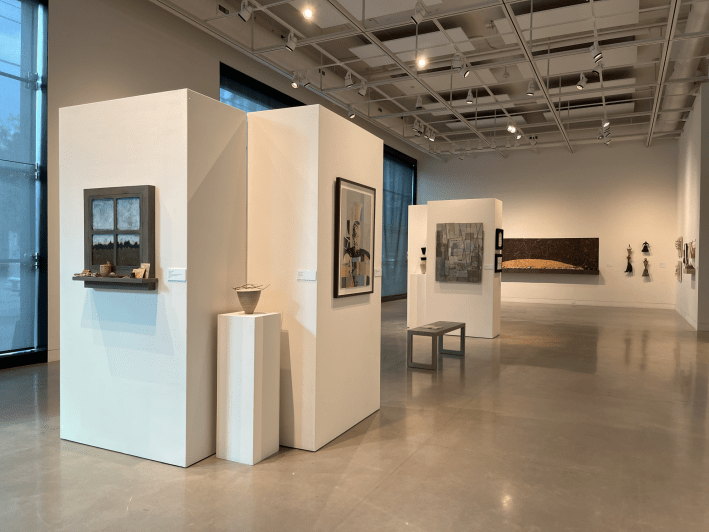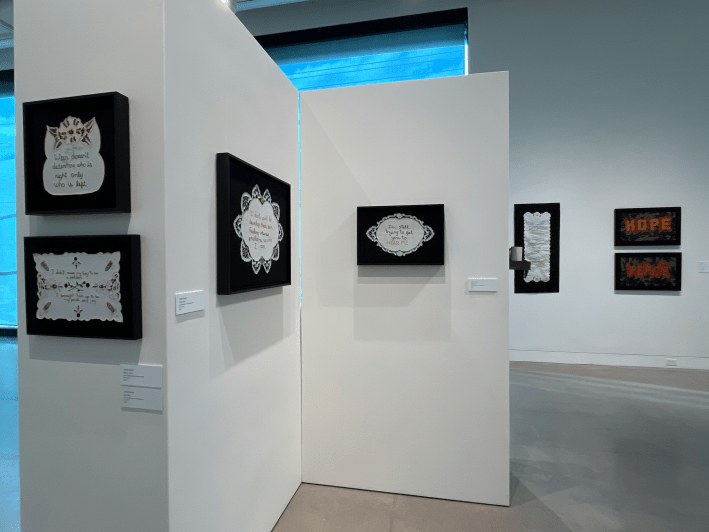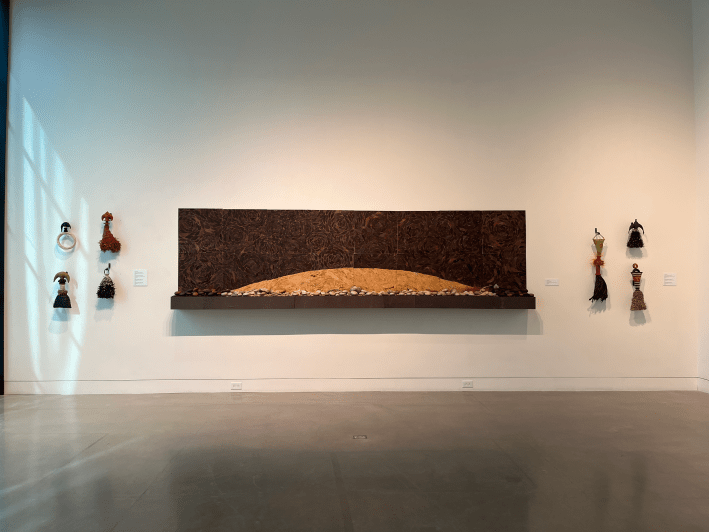Still: Lissa Hunter, Jane Sauer, Jo Stealey and Carol Stein
108 Contemporary
through September 20
The double meaning in this show’s title—“still” as in “even now, after all this time” and “still” as in “quiet, at rest”—is a graceful entry point into this gathering of mixed media works by four women who’ve known each other for decades. Stillness, they suggest, is not stasis or escape; instead it’s a space of attention in which the movements of life reveal themselves.
As seasoned artists and longtime friends based in Maine and Missouri, Lissa Hunter, Jane Sauer, Jo Stealey, and Carol Stein met virtually during Covid for regular conversations about art and life. This group show came out of those talks and continues their ongoing dialogue around subjects both personal and political. What does it mean to still be here, to still be creating? To know the world as still violent yet still precious, still what it’s always been yet still changeable? To hold onto relationships through the shifting tides of a life?
Their curiosity about these questions takes form here in skillful, surprising fine craft pieces with a subtle but strong emotional edge, curated by the artists and laid out in the space with sensitive imagination by 108 Contemporary’s Jolie Hossack. This isn’t an exhibit packed with eye-popping colors or audacious strokes, but it’s not cautious, either. It makes me appreciate the way this gallery presents work from different generations of artists throughout a given year; it’s satisfying to see the results of decades of practice, just as it is to see the efforts of artists newer to the field. In this “craft” discipline, both experimentation and dedication seem to be throughlines, no matter how long an artist has been in the game.

A painting of a window—“Still Life,” by Lissa Hunter—is the first thing you see as you walk into this show, its four panes framing a moody field and forest, with a pale blue sky overhead, painted over black with stormy brushstrokes. The window’s frame extends into a little sill at the bottom, lined with small, carefully rendered objects: a bird’s nest, a comb, a basket, a stack of letters. The viewer is “inside,” standing at the window with the artist, looking ahead into a wild distance even as she’s present with landmarks of her own life’s journey.
That play at a threshold—interior/exterior, the known/the uncertain, the fragile/the enduring, the pause/the action—extends throughout the show. Several pieces by Carol Stein (who’s a psychotherapist as well as an artist) called “No Clear Path” and two titled “Moving Toward Stillness” hang near each other: a journey can be both a peaceful, exploratory meander and the unmarked trail of confusion, even trauma. With care, Stein lays heavy ink over rice paper and slips strips of color together in these works, an effect of coherence within fragmentation.

A bench sits in the middle of the space, with some of those pieces plus Jane Sauer’s hand-stitched quilt (“Ravages of War”) and torn, burned baby dresses (“Why???” and “Collateral Damage”) on one side, and Hunter’s “Biography” on the other. Sitting on that bench, you rest in the center of some very tender human concerns, and the natural and the psychological shift into the overtly political as you move further into the show.



"Biography" (left) and "Ravages of War" (right) | photos by Alicia Chesser
Sauer, who is 87, has seen a lot of life. Many of the words of protest embroidered into her pieces distill something like a mother’s grief and fury into their fierce, tightly framed stitches—a reminder that, especially for women, mild-seeming forms like “craft” have long been subversive avenues for witnessing, expression, and activism.

In a culture that lacks rituals around rage and loss, in a time when protest barely moves the needle, where can we find pathways where things can shift? From the words “hope” and “war” overlaid on each other in two of Sauer’s textile works, I turned a corner to find something that took my breath and messed with my mind in the best way.
In Jo Stealey’s massive “Full Moon Rising,” a huge pale central shape curves up like a whale breaching the ocean’s surface. The closer you get, the more the piece disrupts expectations: the sky is made of swirling leaves; on a ledge below (echoing Hunter’s little windowsill), the landscape shines with shells and fossils among matte rocks. The piece’s skewed perspectives, strangely, helped me see more clearly and break through some binaries. I thought of that line from Ursula K. LeGuin's world of Gethen: "Light is the left hand of darkness, and darkness the right hand of light."

There’s humor here, too—in Stealey’s set of “Tools of Suspect Origin,” which whimsically reimagine familiar forms; in Hunter’s trompe l’oeil dishware, her trio of brushes, and her wire-and-paper branches; and in Stealey’s wonderful “Weights and Measures," a set of slightly improbable life-sized tools from some slightly off-kilter shed, which you could easily walk up and take down from the wall for some unknown use (don’t do that, though).





photos by Alicia Chesser
In addition to its meditations on stillness, “Still” made me reflect on the repetitive tasks of life, many historically designated as "women's work": stitching and folding and cultivating, wrangling the neverending dishes, mourning and laughing and walking each other home, again and again.
These are tasks that, like friendship and art, require and strengthen and reward attention. Steady hands and full hearts crafted the work in this still, quiet show, and these artist-friends sent me off with a gentle message: stay close, stay present, stay ready for what could still be.






